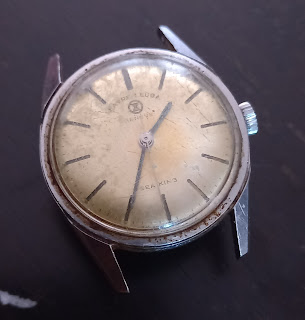#003 Favre-Leuba Sea King (FL111 movement)
Movement : FL111
Year : Late 50s, early 60s(?)
Condition : Dial 4/10
: Case 6/10
: Movement 9/10
Bracelet : Non-original
Crown :Original Favre-Leuba
Crystal : Original tension ring
Serial no. : Case - none
: Movement - 557856
Up today is a Favre-Leuba from the late 50s/early 60s. It is a Sea-King model which I just purchased on ebay. FL seems to have been quite popular in India and I see quite a lot of them being sold on ebay and some of them quite cheaply but buying these Mumbai specials are a gamble so you need to be a bit cautious when buying. Having said that they're cheap so no great loss if you make a bad decision.
This is the auction listing.. the seller was honest and mentioned that the caseback couldn't be opened. Generally this is a show stopper but in some cases it can be a blessing as we will see later. USD25 works out roughly to MYR100 so its worth a gamble.
Picture below is also from the auction listing, the caseback doesn't looked bad, looks like they didn't try very hard to get inside! Another plus point.
Final picture from the auction listing and they both seem to have their original crowns ...quite often they have been replaced with aftermarket ones so having them still on the watch is great. One is a bit worn but I can live with that!
Anyway, when I received the watches I tried to remove the casebacks. I managed to get the back off the blue-dialled watch using normal tools (separate write-up on this watch to follow) but the white-dialled one refused to come off. This caseback had flats instead of notches and while I did have the correct removing tool I couldn't apply enough force. Time to go to plan B.
On time honoured 'trick' for recalcitrant casebacks is to superglue a nut on the back and use a spanner on that. Well I had some superglue (CYA-cyanoacrylate) in the fridge and nuts galore so I duly affixed one to the caseback.
After
about 30 minutes to give the glue time to set I tried to remove the
back with a correct spanner. I couldn't hold the watch tightly as the
lugs were digging into my hand. So an adjustable wrench was brought out
and the watch was secured with the jaws of the wrench in between the
lugs.......success!
With the caseback removed, the movement was revealed. One benefit of the stuck caseback was it did a good job protecting the movement as it looks pristine and free from the ham-fisted butchers from the sub-continent. It is an FL111 calibre which at first glance looks like the ubiquitous ETA1080 but I believe it has some slight differences.
The stem come off by unscrewing the stem-release a little bit, no surprises here.Then there are two half screws which brace the movement and dial against the inner case, to remove the movement these screws need to be screwed 'in' to release pressure on the case, when the cut-off part of the screw is on the outside the movement and dial can be removed
Dial-side of the movement.. quite clean, even the set-lever bridge is intact. These are quite often broken.
The watch is performing well.
Here is the picture of the correct tool used to close up the watch. The case holder was given to me by my late father-in-law along with some other tools, he used to repair watches but his main job was repairing TVs and Radio etc.
A view of the faded FL crown.
Here is the final product, fitted with a period 'bonklip' bracelet. At around 30mm it wears a bit small but not as bad as some others I've got!
Anil Nair
19th January 2022






 \
\







